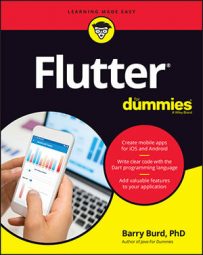 ©Shutterstock/baranq
©Shutterstock/baranq- The Flutter Software Development Kit (SDK)
The Flutter SDK includes lots and lots of prewritten, reusable Flutter code and a bunch of software tools for running and testing Flutter apps. The SDK has the official Flutter code libraries, Dart code libraries, documentation, and even some sample apps.
- An integrated development environment
You can create Flutter apps by using geeky, keyboard-only tools, but eventually you'll tire of typing and retyping commands. An integrated development environment (IDE), on the other hand, is a little like a word processor: A word processor helps you compose documents (memos, poems, and other works of fine literature); in contrast, an IDE helps you compose instructions for processors.
For composing Flutter apps, the Android Studio IDE is an excellent choice. Don't be fooled by the word Android in the IDE's name. Using Android Studio, you can create iPhone apps, web apps, and other kinds of apps.
- Some sample Flutter apps, to help you get started
You can download examples from Dummies.com to get started.
- A device for testing your Flutter code
Most developers focus on the creation of apps for iPhones and Android phones. You can run your code on your own phone, but you can also run it on your computer. To run a mobile app on your computer, you need software that displays a phone on your screen and runs your app within that display.
In the iPhone world, this type of software is called a simulator, and Android calls its software an emulator. Simulators and emulators are examples of virtual devices. In contrast, an actual iPhone or Android phone is called a physical device.
Another name for a physical device is a real device.
An emulator isn't quite the same thing as a simulator. An emulator is software that behaves, to a large extent, like the hardware of a real, physical phone. A simulator is software that runs a phone's apps without really behaving too much like the phone's hardware.
All these tools run on the development computer — the laptop or desktop computer you use to develop Flutter apps. Later, when you publish your app, users run the app on their target devices — physical devices such as iPhones, Android phones, and (someday soon) smart toasters.Here's good news: You can download for free all the software you need to run examples from Dummies.com. The software is separated into four downloads:
- When you visit Flutter’s Install page, you can click a button to install the Flutter SDK.
- You can also download the Android Studio IDE. Along with this download comes the Android emulator.
- com Flutter code also helps you work through some examples.
- The iPhone simulator, as well as all the code you need for generating iPhone apps, comes with the installation of Xcode on your Mac. Xcode is available from the Macintosh App Store. (Unfortunately, you can't develop for iPhone on a Windows PC.)
In the world of mobile app development, things change very quickly. The instructions written on Tuesday can be out-of-date by Thursday morning. The creators of Flutter are always creating new features and new tools. The old tools stop working, and the old instructions no longer apply.
Curious to learn more? Check out the Flutter Cheat Sheet to see some beginner programming tips.

